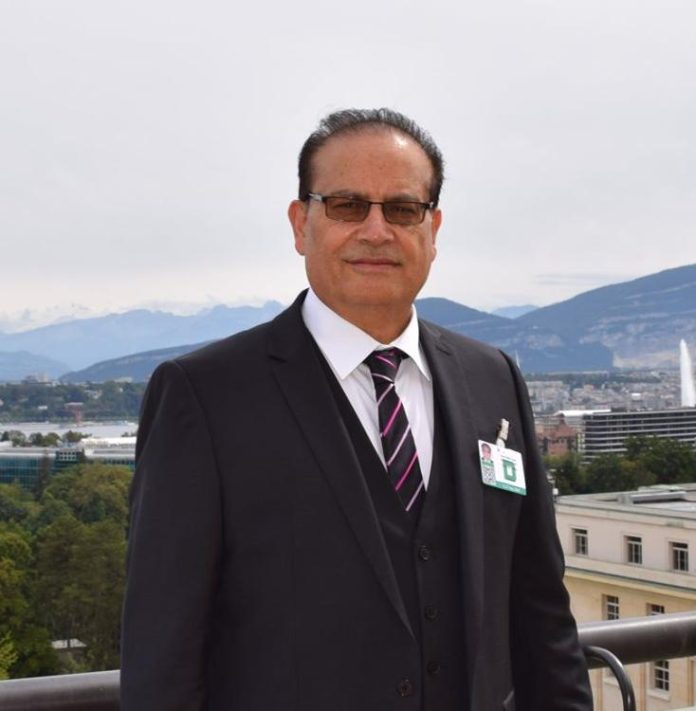By Qamar Bashir
The long-brewing confrontation between Israel and Iran has finally erupted into direct confrontation. After months of devastation in Gaza and precision assassinations in Lebanon and Syria, Israel has now escalated the battlefield to Tehran itself. In a daring and coordinated offensive, Israel launched air and missile strikes deep inside Iranian territory, reportedly targeting nuclear research facilities, air defense systems, ballistic missile stockpiles, and military command centers. According to Israeli claims, several senior military leaders and scientists were killed, and substantial damage was inflicted on key installations.
This attack, although sudden in execution, was far from unexpected. I had earlier written—and consistently emphasized—that the real Israeli objective was never just Hamas or Hezbollah. Those were merely stepping stones in a broader strategy aimed squarely at Iran, whom Israel sees as the ideological, financial, and logistical nucleus of anti-Israel militant activity in the region. The elimination of Hamas’s leadership, including Ismail Haniyeh, and the successive neutralization of Hezbollah’s command under Hassan Nasrallah, were deliberate moves to clear the path for a direct strike on Iran. As I noted then in an article titled: “It is not Hamas that is the ultimate target, but Iran—and sooner or later, Israel will strike.”
Despite a barrage of Iranian drone and missile retaliation following Israel’s operations in Gaza and Lebanon, Israel did not immediately retaliate against Iran’s homeland. This delay perplexed many observers. But strategically, it made perfect sense. Israel’s first objective was to degrade Iran’s outer defense perimeter—its proxies: Hamas in Gaza, Hezbollah in Lebanon, and the Houthis in Yemen. Israel methodically eliminated the top command of Hamas and continued high-profile strikes on Hezbollah, including those that killed Fuad Shukr, Taleb Abdallah, and other senior operatives.
This proxy war phase was a calculated move to weaken Iran’s retaliatory arms. Once the regional tentacles were sufficiently blunted, Israel turned its attention to the source: Tehran.
The precision with which this attack was executed mirrors earlier Israeli operations, such as the assassinations of Quds Force commanders in Damascus and the stealth killing of Ismail Haniyeh while under IRGC protection in Iran. Reports suggest that Israel deployed a combination of long-range missiles, advanced drones, and possibly cyber warfare tools to disable Iranian radar systems ahead of the attack.
Among the targets reportedly hit were Iran’s Natanz and Fordow nuclear enrichment facilities, multiple ballistic missile depots near Isfahan, and key command bunkers in Tehran. Israel also claims to have eliminated a number of senior IRGC commanders and nuclear scientists critical to Iran’s uranium enrichment and missile development programs. Although Iran has yet to officially confirm the scope of damage, the silence from Tehran suggests a period of shock and damage assessment before retaliation.
For over three decades, Iran has operated under crushing Western sanctions. Despite limited access to advanced military hardware, Iran has managed to develop indigenous ballistic missile and drone capabilities. However, the recent Israeli strike has called into question the true effectiveness of Iran’s deterrent power.
Iran’s April retaliatory strike on Israel using drones and missiles exposed vulnerabilities. Most of its projectiles were intercepted mid-air by Israel’s layered air defense systems—Iron Dome, David’s Sling, and Arrow. The strike caused minimal damage and maximum embarrassment. The same pattern repeated itself in this latest exchange, suggesting that Iran’s offensive capabilities may be more symbolic than strategic.
President Donald Trump, in his second term, had openly discouraged Israeli strikes while actively pursuing nuclear negotiations with Iran. His envoy was scheduled to meet Iranian Foreign Minister Abbas Araghchi in Oman when the strikes occurred. Trump warned that the operation could derail delicate diplomacy, stating, “I don’t want them going in because, I mean, that would blow it.”
But Iran is unlikely to remain passive. The regime’s credibility—both domestically and regionally—is at stake. It may activate what remains of Hezbollah, mobilize pro-Iran militias in Iraq and Syria, and possibly target American military bases in the Gulf. However, such actions risk triggering a wider conflict that Iran may not be prepared to sustain—militarily, diplomatically, or economically.
This war, unlike previous confrontations, is not confined to a single geographic theater. It is already spilling over diplomatically, economically, and ideologically. The Strait of Hormuz, which sees nearly 20% of the world’s oil shipments, is now at the center of global concern. Any Iranian attempt to disrupt this chokepoint will send global oil prices skyrocketing, potentially triggering inflation, economic slowdowns, and supply chain disruptions—particularly in vulnerable economies like Pakistan, Afghanistan, and parts of Africa.
Regionally, Pakistan must brace for the potential fallout. A full-scale Iran-Israel war could create a new refugee crisis, possibly pushing Shia communities toward Pakistan’s borders, further straining its fragile economic and social fabric. Ethnic and sectarian spillovers could ignite unrest in sensitive areas already on edge due to internal instability.
On a global scale, Iranian diasporas may stage protests, cyber attacks, or other non-kinetic responses. Human rights organizations and anti-war movements are also expected to rally against Israel’s aggression, just as they have against its actions in Gaza. The United Nations will soon become another front, with Iran pushing for international sanctions on Israel and the latter leveraging its alliances to block such moves.
Israel’s response to the October 7 Hamas attack, which killed 1,200 Israelis, has already resulted in the deaths of over 70,000 Palestinians, according to credible international estimates. This level of retribution has drawn severe criticism and raises critical questions about the doctrine of proportionality. Now, with direct military strikes on Iran, the scale of escalation suggests that Israel is prepared to operate outside established norms of proportional response, prioritizing complete neutralization over measured deterrence.
If the goal is to prevent a future nuclear-armed Iran, the stakes are existential. Public intelligence assessments suggest that Iran has not yet achieved weapons-grade enrichment, though it is believed to be close. If Iran already has bomb-grade material and a delivery system, Israel’s gamble could backfire catastrophically. A single nuclear strike on Israeli territory—small as the country is—could be existential.
But this scenario rests on assumptions that are, so far, unverified. If Iran does not yet possess nuclear capability, the conflict may remain conventional. In this case, Israel’s superior airpower, advanced missile defense systems, and deep intelligence capabilities give it a significant edge.
Israel has stated this is not a one-off attack but the beginning of a prolonged campaign. The declared objectives include complete dismantling of Iran’s nuclear capability, ballistic missile infrastructure, air defense systems, and command structure. If successful, this campaign could redraw the strategic map of the Middle East.
The strike has also laid bare the powerlessness of international institutions. The UN, the International Court of Justice, and the global civil society have issued statements—but Israel acted undeterred. Even the International Atomic Energy Agency’s resolution condemning Iran has failed to create any viable deterrence.
Meanwhile, Muslim nations, despite their collective population and wealth, remain spectators. No unified diplomatic or kinetic response has emerged. This exposes not just a military imbalance, but a broader geopolitical humiliation of the Muslim world.
Former Israeli Prime Minister Naftali Bennett justified the strikes by warning that failure to stop Iran could unleash a nuclear arms race across the Middle East—with Turkey, Egypt, and Saudi Arabia all seeking nuclear capabilities. “It’s time to hit the head of the octopus,” he said, calling Iran the epicenter of terror.
Netanyahu echoed this in his national address: “We struck at the head of Iran’s nuclear weaponization program… This is not a one-day attack. It will continue until the threat is removed.”
Israel’s ability to act unilaterally, even against U.S. advice, and without fear of diplomatic fallout, raises profound questions about the current global order. Israel, a tiny nation geographically, now flexes geopolitical muscle equal to—or beyond—that of traditional superpowers.
The events unfolding are more than military maneuvers—they mark the beginning of a new geopolitical epoch. With China, Russia, and the EU largely silent or paralyzed, the illusion of a balanced multipolar world is crumbling. Israel’s actions suggest that global influence is no longer a function of size, economy, or alliances—but of audacity, conviction, and superior military capability.
The strategic, moral, and institutional implications are enormous. Will the world allow the Middle East to descend into nuclear chaos? Will diplomacy resurface, or will military unilateralism become the new norm? And perhaps most importantly, will the Muslim world continue to watch in stunned silence, or will it finally forge a unified response to prevent the annihilation of its own geopolitical dignity?
History is no longer being shaped behind closed doors. It is being rewritten in missile smoke over Tehran. And the world is watching—some in horror, some in awe, and most in helplessness.
By Qamar Bashir
Press Secretary to the President (Rtd)
Former Press Minister at the Embassy of Pakistan to France
Former MD, SRBC
Macomb, Michigan, USA

















